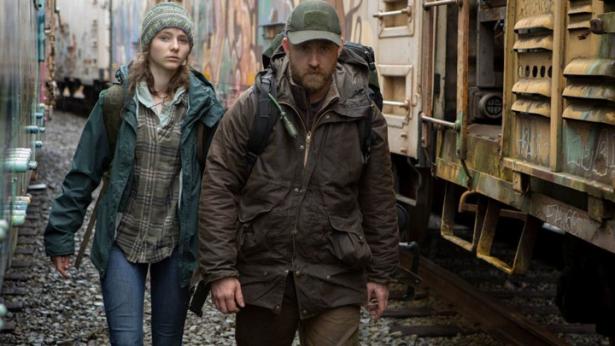Early on in Leave No Trace, Will (Ben Foster) and Tom (Thomasin McKenzie) have moved into a modest, charming home in Oregon’s countryside, with assistance from the state and from a local farmer who took pity on their situation. Will and Tom were homeless, and the first act of the film focuses on their life camping in a large nature preserve outside of Portland before they’re arrested and taken into custody. The new home they’re placed in seems like a paradise compared to their time in the woods, but to 13-year-old Tom and (especially) her father, it’s a frightening place that’s little more than a gilded cage.
“We can still think our own thoughts,” Will tells Tom. That’s all the reassurance he can offer, and it’s clear he thinks it won’t be enough. Leave No Trace is a film about living off the grid in America, but not as a political act or as a desperate struggle to survive. It’s a story of a family seeking harmony with the land, and with their country, that doesn’t feel preachy or touristy. The movie marks a welcome return for the director and writer Debra Granik (and her co-writer and producer, Anne Rosellini), who last made the enthralling drama Winter’s Bone in 2010. That movie was one of the best of the year and helped introduce Jennifer Lawrence to audiences; similarly, Leave No Trace is one of the best films of 2018 and promises to make a star of McKenzie.
Granik has now made three fiction films (there’s also 2005’s Down to the Bone), all of which share an aptitude for small-scale storytelling, an incredible feel for realistically depicting environments and communities, and quiet but astonishing performances. She’s one of the most talented directors of acting today, and in Leave No Trace, she’s getting subdued, career-best work from Foster (a performer who tends toward the melodramatic), alongside McKenzie’s breakout and a touching supporting turn from Dale Dickey.
The story, adapted by Granik and Rosellini from Peter Rock’s novel My Abandonment, begins with Will and Tom in the woods. They play chess, forage for food, and generally avoid people, occasionally scrounging up money by selling Will’s PTSD medication (he’s a military veteran of an unnamed war) on the black market. Granik is careful not to idealize their solitary lifestyle even as she finds the humor and love in their situation, which is presented as a simpler alternative to regular society rather than as a total retreat from it.
Still, there’s no question that Will is haunted by his past. The film spares the audience from plodding flashbacks, or sensationalized nightmares, relying on Foster to communicate his character’s general unease. The sound of cars, planes, and city bustle (the father and daughter occasionally hike into Portland for supplies) is jarringly loud in the movie’s overall mix, heightening the anxiety anytime Will and Tom are out of their element. But before long, they’re discovered by park rangers and ripped from their home; the rest of Leave No Trace sees them trying to find a new one, and follows the tensions that surface between them as a result.
The script dodges many of the clichés that viewers might expect from such a story. It refuses to descend into outright bleakness or violence. And Granik doesn’t render nature with some kind of poetic transcendence: She sees beauty in the woods as well as the harshness of life there. She also understands the comforts of the more “civilized” existence the government tries to impose on Will and Tom, and the pressures that come with that way of life.
Will is a character who never seems quite comfortable unless he’s with his daughter, outside, free of the more stifling aspects of society. It’s Tom who’s truly caught between worlds. She is her father’s daughter, and is happy living with him, but he hasn’t brainwashed her to a survivalist philosophy. As Leave No Trace progresses, its two characters stay together though their outlooks begin to diverge. Will is seeking a restoration of the balance he had largely achieved at the start of the film, while Tom starts wondering if some compromise—a life with a little extra community and infrastructure—would suit her better. Granik plays that growing conflict out with love and understanding, as Will and Tom journey north from the more restrictive farming town they’re initially placed in and come across other alternative living situations.
Granik’s ability to convey so much about how a community works without didacticism is part of what made Winter’s Bone (which was set in the Ozarks) such a thrill to watch. While Leave No Trace is a more muted drama, it has a similarly firm grasp on its characters and the places they comes across. The result is a travelogue through an ignored part of America that’s imbued with empathy; when Will and Tom’s journey comes to an end, it’s heartbreaking, soaring, and necessary, all at once. It may be Hollywood’s fault that it took Granik this long to make another narrative feature, or she may have been looking for the right story to tell, but either way, this is a film that confirms her as an essential creative force.
David Sims is a staff writer at The Atlantic, where he covers culture.


Spread the word